Newsletter July 2020
President's Message
Notre-Dame Cathedral: Will it get a new wooden roof?
I watched a video of a French group, Carpenters Without Borders, demonstrating the making of a new roof truss for the Notre-Dame Cathedral using the same techniques used by the Japanese woodworkers who demonstrate at the annual Kezurou-kai event held in our area (most years)
The group made a gigantic roof truss for the cathedral just using axes and chisels, hewing the timbers square and then cutting the large joints.
The carpenters used eight 80 to 120 years old Oak trees and said it would require only 1000 trees to make all of the roof structures.
Their claim is that there are plenty of old trees in France to consider making the new roof from and a wooden roof would last longer than one made from concrete or steel. The last wooden roof lasted over 8 centuries.
From the video they appeared to have about 25 carpenters, male and female, working on the project, all wearing substantial shin guards. The cutting took about a week and the up-righting of the truss at the end required some understanding of leverage plus lots of strong bodies.
I am sure, using big power sawing machines, a new wooden roof could be complete in a reasonable time.
Notre-Dame Cathedral youtube.com
Enjoy your woodwork Frank (Contact at: Frankramsay8@aol.com)
Top
Announcements:
The Zoom meeting was called to order by President Frank Ramsay at 6 PM. He announced that Foster City meeting rooms will likely not be available until September, so we will be meeting on Zoom until at least then.
The next shop tour will cover small parts storage.
Featured Speaker: Michael Wallace "Shaker Legacy"

Frank introduced our speaker, Michael Wallace, a former member of Sonoma County Woodworkers whose topic was Shaker Furniture. Mike first described the
legacy of the Shakers and the historical development of the Shaker community. He then continued on to describe the development of their furniture style.
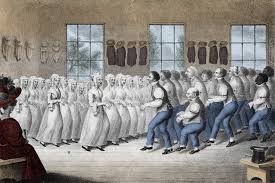
Shaker dancing
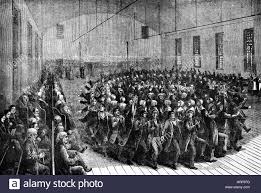
Shaker dancing

A Shaker Meeting (with non-members watching)
Their religious movement began in 1647 when they split off from the Quakers, when they gained their name as "shaking Quakers" because of their energetic style of
dancing. Mother Ann Lee, born in 1736, was the most revered leader. She married in 1762, and had 4 children, all of whom died early. She joined the Shakers in 1758
and wrote the Manifesto of Divine Light in 1770. The doctrine required celibacy so the movement could only maintain its numbers by attracting converts. They left
England in 1774 for Watervliet (now Niskayuna, NY). They adopted the official name of United Society of Believers in Christ's Second Coming. They went on to
establish 18 communities, mostly in the northeastern US, and reached a peak of 6500 members. The elements of their beliefs were as follows:
Celibacy when couples joined, they were split up and their children removed from their care. Women could not be alone in the company of a single man.
Equality of the sexes-all did the same work. Leaders were often women.
Racial equality-even though slavery was still practiced in the US.
Pacifism they did not believe in military service
Charismatic worship
Their life was highly regimented. They all awoke between 5.00 and 5:30 and went to work. They breakfasted at 7:00 and then went back to work. Lunch was at noon
followed by work until dinner at 8 PM. After dinner they would retire to common rooms. The church declined after the Civil War, partly due to the Industrial
Revolution and its enormous need for skilled labor and the opening of the west. Membership dropped precipitously in 1900. At present the last community in
Sabbathday Lake has only 2 old people remaining.
Shaker furniture has 3 recognized periods:
Primitive-before 1820. There are not many pieces left from this period as the Shakers recycled all their old furniture.
Golden Age-1820-1850
Victorian-after 1850

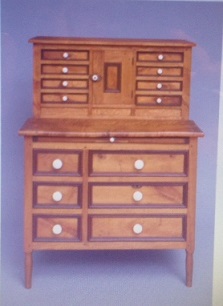
The design, construction, and finishing of the furniture was ruled by the Millennial Laws which were first promulgated in 1820 and significantly revised in
1845.Shaker ideas were similar to those of Louis Sullivan…" form follows function". Shakers often bought items from others and stripped them of ornamental features.

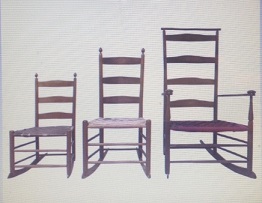
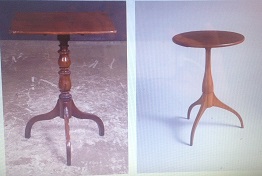
Some examples shown were benches, a chest, an adult cradle for when people were ill, a ladder-back chair, a center post table, and a Victorian multi-drawer chest. They would use whatever wood was available and often painted the furniture.
In 1937, historian Edward Andrews visited all the communities and bought furniture. He compiled his experiences in a photographic history. In 1935, the Whitney
Museum was the first to exhibit Shaker handicrafts.
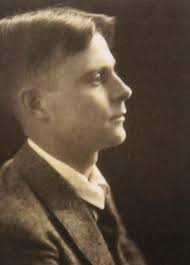

The Shakers also influenced many Swedish craftsmen: Keare Klimt was a leader in modern Swedish furniture
design, Hans Wegner, a Swedish rocker builder, and Borge Mogenson, a chair builder. In the US, they influenced George Nakashima as well as the founder of the
Arts and Crafts movement, Gustav Stickley.
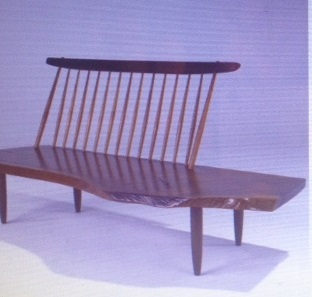
George Nakashima chair
The question period after the presentation was a lively discussion of the Shaker Box and its simple design and, as Michael attested to, difficult to construction.
(In the screen shot above Michael has a background of the 3 standard sizes of Shaker Boxes painted in approved Shaker colours)
Top
Virtual Shop Tour
Paul Krenitsky: Easy Shop Aids
Paul introduced the contributions to the Virtual Shop Tour:
Claude Godcharles
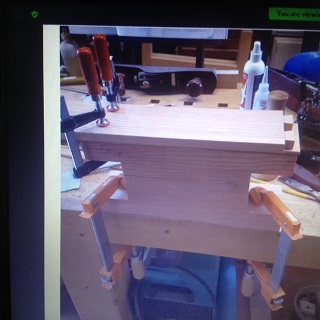
Claude described a "bench bull" based on the design of Linderman
for raising work above bench level
for such tasks as chopping dovetails.
Jon Kaplan

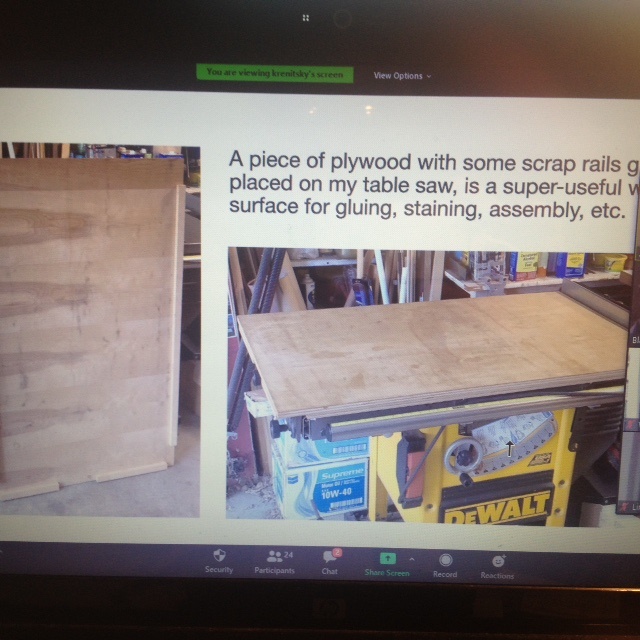
Jon showed a plywood cover for the top of his table sawand a knock down table, 3 feet x 5-1/2 feetwhich he can set up and tear down in less than 5 minutes.
Ken Napior

Ken showed a fixture to transport and use his cutoff saw.
Burt Rosenzweig

Burt described a homemade featherboard.
Jamie Buxton
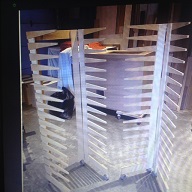
Jamie showed some foldable drying racks for finished parts
as well as some folding sawhorses which are very quick to set-up.
Top
Show and Tell
Lloyd Worthington-Levy
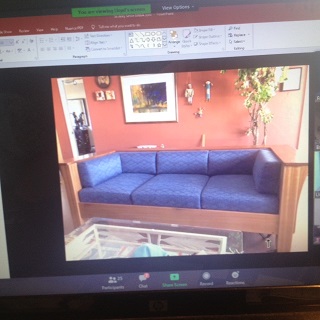
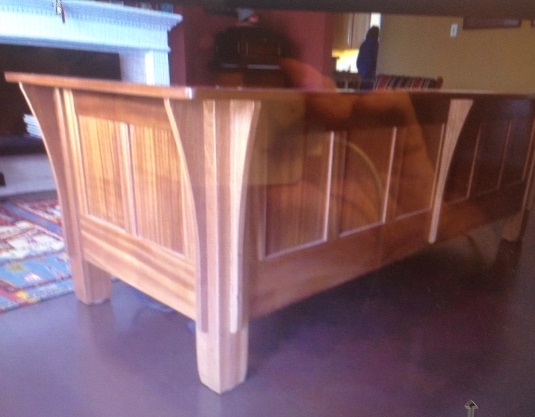
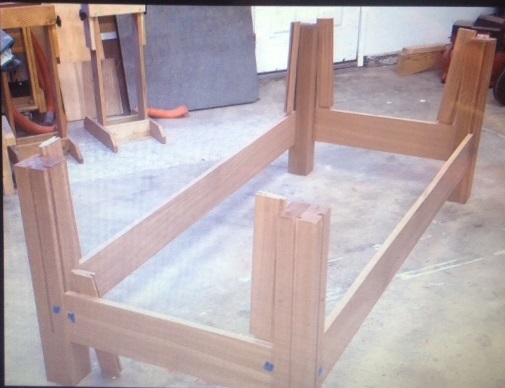
Lloyd described a Stickley settle he built using sapele after the design of one he saw at the Robie House in Chicago. He got measured photos and converted
them to Sketchup drawings. He likes to pre-finish parts as he assembles the piece. He used General Finishes water-based urethane; 3 coats, followed by wax.
Jamie Buxton mentioned that he had built the same piece out of white oak, which he showed to the group (a definite benefit of meeting over Zoom.)
Bill Henzel
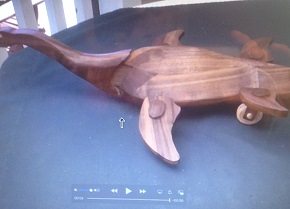
Bill described a set of toy dinosaurs, which make complex motions when pulled.
They are made from laminated lumber.
Frank Ramsay
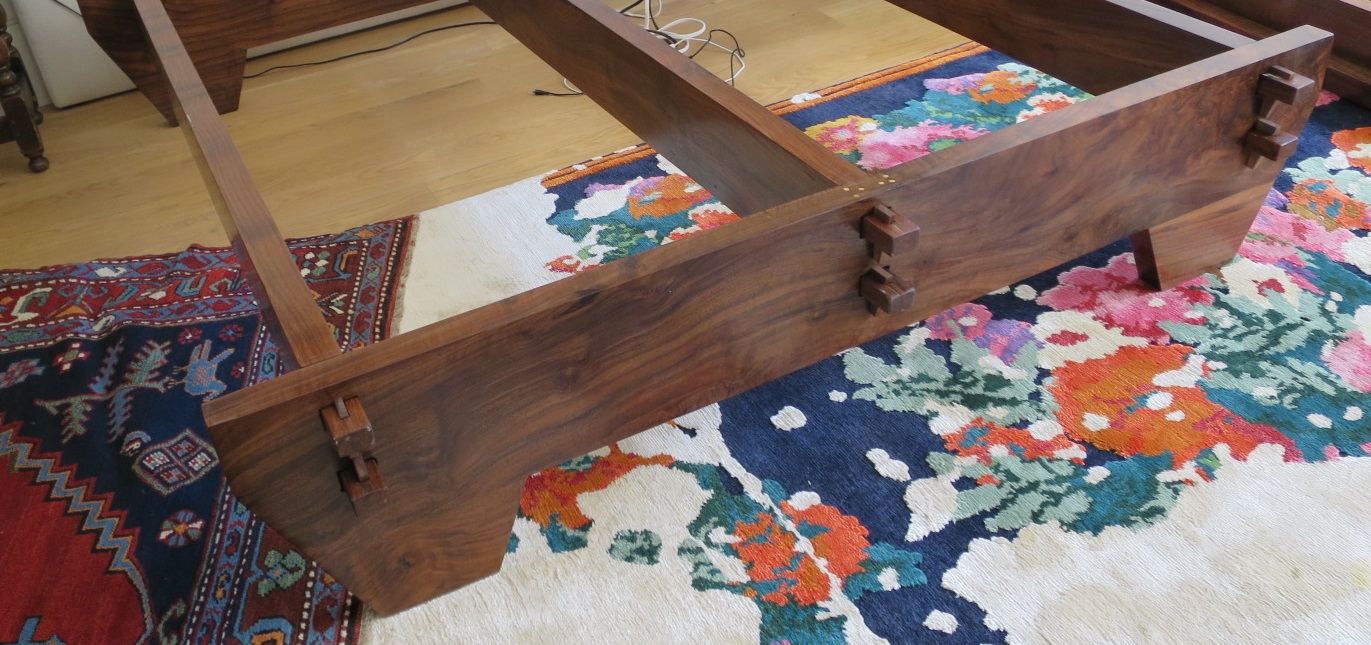
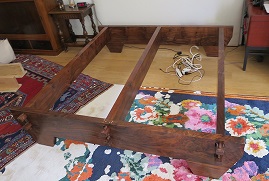
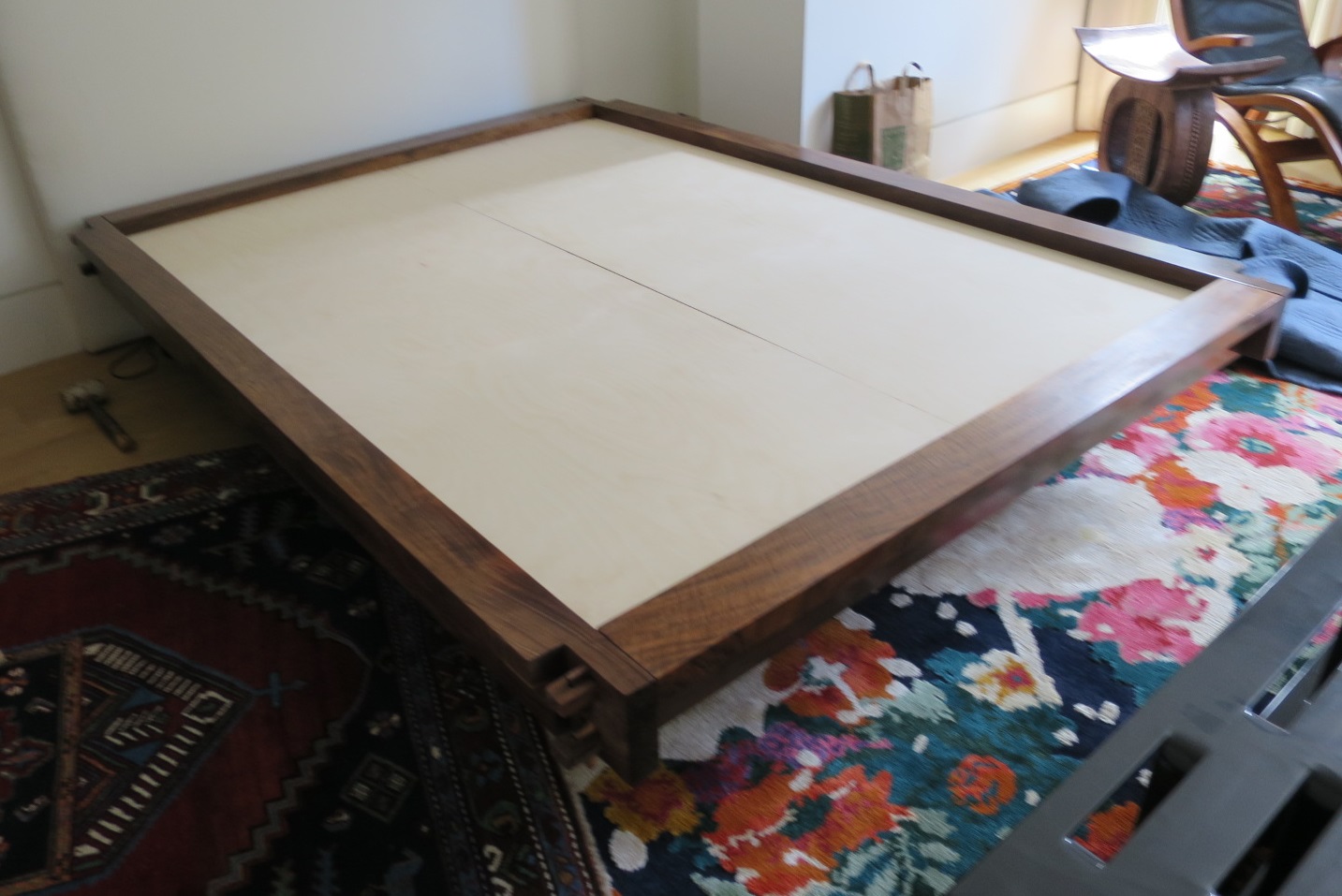
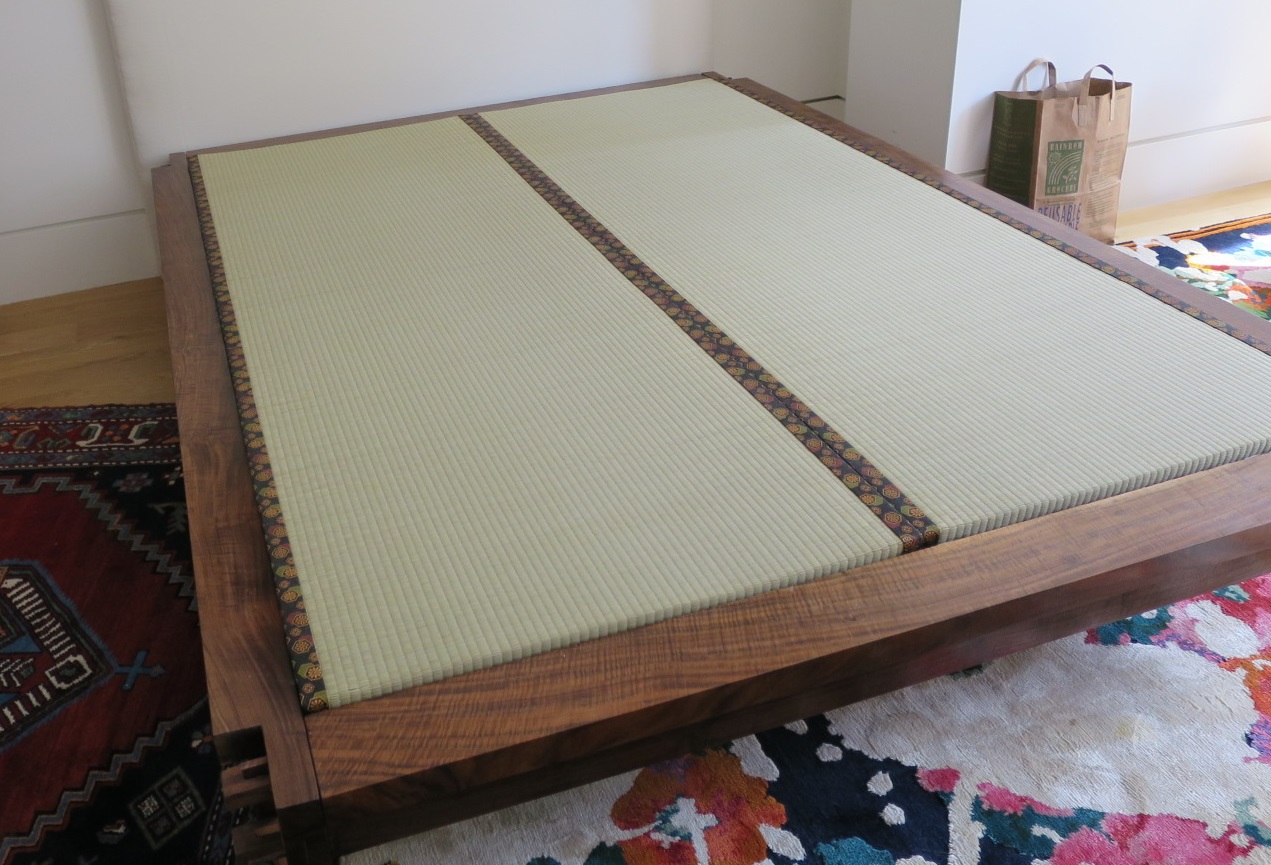
Frank described a Japanese inspired bed he made out of California Black Walnut. It consists of a plywood base surround by solid wood frame
pieces with tatami mats on top. Finish is Tung Oil
The design is a copy of a bed the owner originally had made by a Korrean Korean woodworker in New York many years ago. It is made with Californian Walnut that
came that came form trees in the central valley that were planted about 100 years ago and cut down early this century. The wood came from Robert Beauchamp,
(thewalnutplace.com) It is very dense and heavy, like dealing with steel.
Bruce Powell
Bruce gave a tribute to John Blackmore in honor of his long service to the club over 20 years of membership. Some of the work he showed included
a tori gate, a walnut table, a dining room table and bench, a "best of show" table in our 2011 woodworking show, 2 dining room chairs, a desk project for
the 2014 woodworking show, which won the "People's Choice Award", an office suite in 2015, a live edge table in 2018, as well as 17 jewelry boxes, and 2 doors in 2019.
Tom Gaston
Tom Gaston showed a facility he designed for his lathe to contain and suck the fine dust out of the shop.
Minutes by Steve Rosenblum, Secretary
Top
Featured Speaker: Michael Wallace "Shaker Legacy"

Frank introduced our speaker, Michael Wallace, a former member of Sonoma County Woodworkers whose topic was Shaker Furniture. Mike first described the legacy of the Shakers and the historical development of the Shaker community. He then continued on to describe the development of their furniture style.

Shaker dancing

Shaker dancing

A Shaker Meeting (with non-members watching)
Their religious movement began in 1647 when they split off from the Quakers, when they gained their name as "shaking Quakers" because of their energetic style of dancing. Mother Ann Lee, born in 1736, was the most revered leader. She married in 1762, and had 4 children, all of whom died early. She joined the Shakers in 1758 and wrote the Manifesto of Divine Light in 1770. The doctrine required celibacy so the movement could only maintain its numbers by attracting converts. They left England in 1774 for Watervliet (now Niskayuna, NY). They adopted the official name of United Society of Believers in Christ's Second Coming. They went on to establish 18 communities, mostly in the northeastern US, and reached a peak of 6500 members. The elements of their beliefs were as follows:
Celibacy when couples joined, they were split up and their children removed from their care. Women could not be alone in the company of a single man.
Equality of the sexes-all did the same work. Leaders were often women.
Racial equality-even though slavery was still practiced in the US.
Pacifism they did not believe in military service
Charismatic worship
Their life was highly regimented. They all awoke between 5.00 and 5:30 and went to work. They breakfasted at 7:00 and then went back to work. Lunch was at noon followed by work until dinner at 8 PM. After dinner they would retire to common rooms. The church declined after the Civil War, partly due to the Industrial Revolution and its enormous need for skilled labor and the opening of the west. Membership dropped precipitously in 1900. At present the last community in Sabbathday Lake has only 2 old people remaining.
Shaker furniture has 3 recognized periods:
Primitive-before 1820. There are not many pieces left from this period as the Shakers recycled all their old furniture.
Golden Age-1820-1850
Victorian-after 1850


The design, construction, and finishing of the furniture was ruled by the Millennial Laws which were first promulgated in 1820 and significantly revised in 1845.Shaker ideas were similar to those of Louis Sullivan…" form follows function". Shakers often bought items from others and stripped them of ornamental features.



Some examples shown were benches, a chest, an adult cradle for when people were ill, a ladder-back chair, a center post table, and a Victorian multi-drawer chest. They would use whatever wood was available and often painted the furniture. In 1937, historian Edward Andrews visited all the communities and bought furniture. He compiled his experiences in a photographic history. In 1935, the Whitney Museum was the first to exhibit Shaker handicrafts.


The Shakers also influenced many Swedish craftsmen: Keare Klimt was a leader in modern Swedish furniture design, Hans Wegner, a Swedish rocker builder, and Borge Mogenson, a chair builder. In the US, they influenced George Nakashima as well as the founder of the Arts and Crafts movement, Gustav Stickley.

George Nakashima chair
The question period after the presentation was a lively discussion of the Shaker Box and its simple design and, as Michael attested to, difficult to construction. (In the screen shot above Michael has a background of the 3 standard sizes of Shaker Boxes painted in approved Shaker colours)
Top
Virtual Shop Tour
Paul Krenitsky: Easy Shop Aids
Paul introduced the contributions to the Virtual Shop Tour:
Claude Godcharles

Claude described a "bench bull" based on the design of Linderman
for raising work above bench level
for such tasks as chopping dovetails.
Jon Kaplan


Jon showed a plywood cover for the top of his table sawand a knock down table, 3 feet x 5-1/2 feetwhich he can set up and tear down in less than 5 minutes.
Ken Napior

Ken showed a fixture to transport and use his cutoff saw.
Burt Rosenzweig

Burt described a homemade featherboard.
Jamie Buxton

Jamie showed some foldable drying racks for finished parts
as well as some folding sawhorses which are very quick to set-up.
Top
Show and Tell
Lloyd Worthington-Levy



Lloyd described a Stickley settle he built using sapele after the design of one he saw at the Robie House in Chicago. He got measured photos and converted them to Sketchup drawings. He likes to pre-finish parts as he assembles the piece. He used General Finishes water-based urethane; 3 coats, followed by wax. Jamie Buxton mentioned that he had built the same piece out of white oak, which he showed to the group (a definite benefit of meeting over Zoom.)
Bill Henzel

Bill described a set of toy dinosaurs, which make complex motions when pulled.
They are made from laminated lumber.
Frank Ramsay



